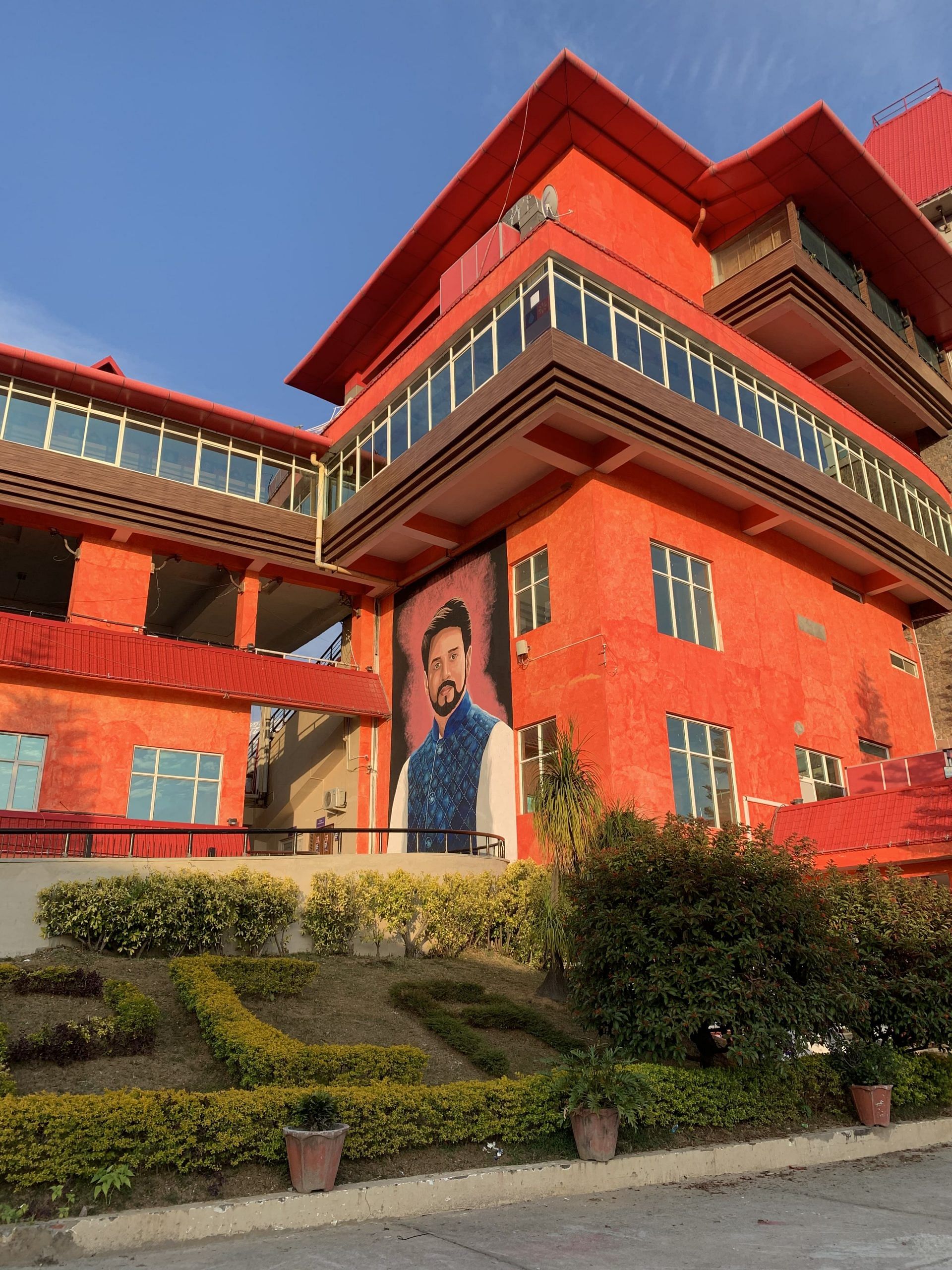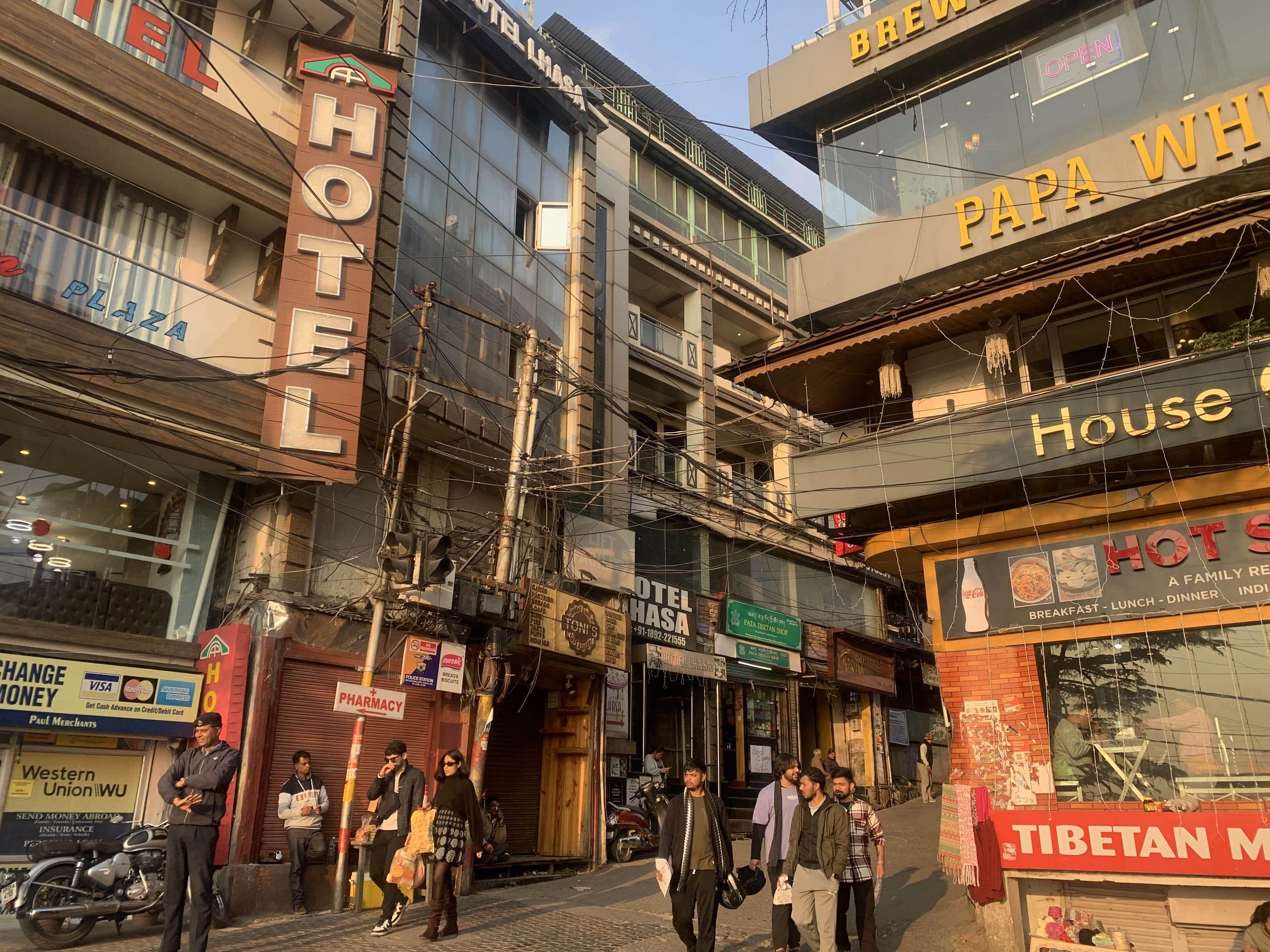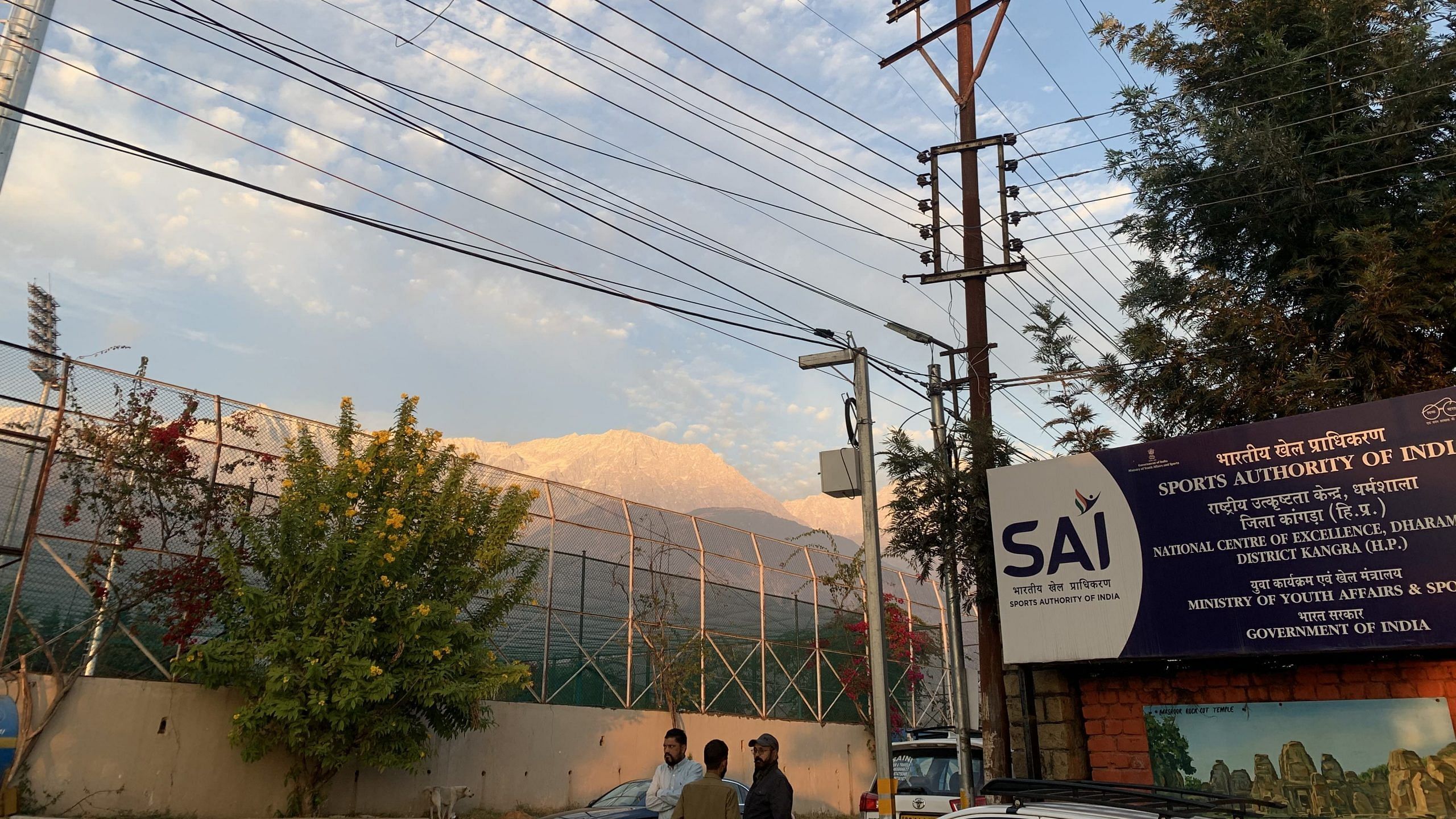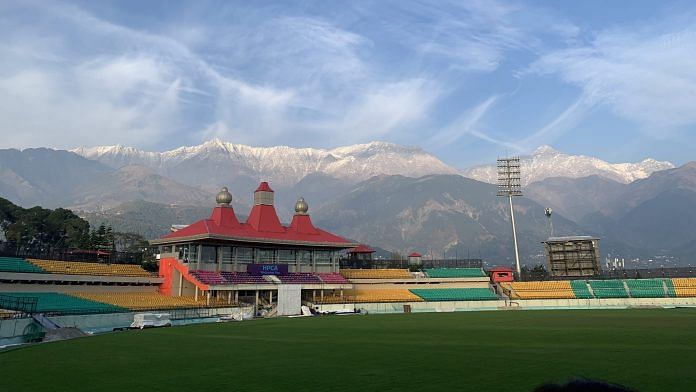Dharamshala: Cries of ‘Jeetega bhai jeetega, India jeetega’ fill the stands. But there’s no one to soak up the noise. The stadium is empty. An ardent group of tourists and fans gather every day at the HPCA stadium in Dharamshala, simply to take it all in—a gaggle of selfie-takers, an enraptured audience watching no one, and cricket strategists with no match to dissect.
Dharamshala is changing, from soul tourism to stadium tourism, Tibet to T20. ‘If you build it, they will come’ is now the central motif of the Himalayan town popularly known more for grungy bliss-seeking Buddha bar hoppers. The town’s future is on steroids. New hotels, a new convention centre, airport expansion and perhaps even an IT park are dominating official PPTs and conversations.
The Himachal Pradesh Cricket Association (HPCA) stadium has given Dharamshala tourism a new lease of life. Five World Cup matches, especially an India-New Zealand encounter, have opened the floodgates. From Jammu and Kashmir to Gujarat, cricket mania is being directed by way of the Dhauladhar mountains.
The world’s highest cricket stadium is a sight to behold. It’s framed by snow-capped mountains, the white enhanced by a flaming orange sunset. Despite being relatively small, with a seating capacity of about 20,000, there’s a grandeur, a cinematic quality to the stadium that leaves spectators spellbound. “The World Cup final should’ve happened here, not in Ahmedabad,” says Gurinder Pal Singh. A resident of Jammu and Kashmir, Singh has come to Dharamshala with his friends for the weekend. The stadium, with its strobe-lit red roof, was on the top of their list of places to visit.
“More people are coming to see the stadium than the Dalai Lama,” laughs Sanjeev Thakur, who works as a driver in Dharamshala and McLeodganj.
The tourism industry was the worst hit in all of Himachal. Tourism had been declining for 3-4 years. Cricket has been our ray of hope
A World Cup push
At any given point of the day, with a surge during the weekends, there are about 50-60 people at the stadium, which underwent a makeover in the run-up to the ICC Cricket World Cup. Every few kilometres in Dharamshala, there is a benevolent welcome to the World Cup from Anurag Thakur—his face splashed on several billboards. When it gets excessive, posters of the smiling face of Arun Singh Dhumal, IPL chairman and Thakur’s younger brother, do the job. On the stadium building wall, a giant oil portrait of Thakur looks down benevolently. Constructing the stadium was a tedious process, since it’s built on the slope of a mountain, but the Union sports minister and former HPCA president was determined, and it was completed in 2004.

There are 890 hotels and guest houses in Kangra, a district in Himachal Pradesh; Dharamshala has 600. According to data shared by the tourism industry, during the India-New Zealand match, hotels and homestays in the lower portion of the town, which is where the stadium is, were operating at 100 per cent occupancy. Higher up, in McLeodganj, home to Tibetan settlements, the Dalai Lama, and a deluge of eateries, approximately 80 per cent of hotels were occupied. “Cricket-lovers want to stay close to the action. They want to walk to the stadium. They don’t want to get stuck in traffic,” explains Vinay Dhiman, deputy director, tourism, Himachal Pradesh.
More people are coming to see the stadium than the Dalai Lama
Last October, the town hosted 34,000 domestic tourists and 1,000 international visitors. This year, due to the cricket matches, 55,000 Indian tourists came to Dharamshala while international tourists numbered 2,500. “They all had words of praise for the arena and said it was the best the country had to offer to fans,” says Mohit Sood, media specialist at the HPCA. According to Sood, the stadium welcomes over 2,000 visitors each day.
“Both have increased significantly because of the world-cup,” says Dhiman. “Investments and queries from hotel chains are pouring in.”
And the Delhi influence is palpable. The golgappa, paapdi chaat stands now occupy prime real estate on the Temple Road, next to thukpa, laphing, and prayer wheels.

A single section, located at the lower-end, is open to the public. The seats haven’t been cleaned. This is a stark contrast from the higher floors of the stadium, where the seats are still wrapped in the orange-gold cloth left over from the tournament. But the fans are unbothered, and the frenzied selfie-clicking continues. “Yahan se Yuvraj Singh ne chakka maara tha [Yuvraj Singh scored a six from here],” one excitedly tells another.
The drama is deliberate; there are chandeliers and pearl-coloured pillars. On the top floor, inside one of the corporate boxes, is a wood-panelled bar. A glass screen separates spectator and stadium, and the view is straight out of a film—the mountains are resplendent in their glory—possibly stealing the players’ spotlight. “Players are probably tempted to throw the ball from the ground and into the sky,” said Raghav Guleria, former journalist and a hotelier.
Rents are now far higher than they used to be, as are living costs. Purchasing land is out of the question. International citizens have now been relegated to the corners of the town, while popular spaces are dominated by Delhiites, Punjabis, Haryanvis, as well as a smattering of Gujaratis and Maharashtrians.
When the matches were broadcast, cameras focussed on the stadium. “People had been watching matches, seeing the snow and the stadium on their screens. It’s only natural that they would want to see it in real life,” said Ritu Sarin. She and her partner Tenzing Sonam are founders of the Dharamshala International Film Festival. “Whoever visits Dharamshala comes to the stadium. The tea gardens and the stadium—these are the two spots no one misses,” said Guleria.
Also read: Himachal floods a perfect storm––multi-storey buildings on shaky mountaintops
It all revolves around the stadium
In 2008, the HPCA Stadium didn’t have all the bells and whistles that it boasts today. When IPL matches were scheduled at the HPCA Stadium, there were no five-star hotels, and to the chagrin of the administration, there was hardly any infrastructure or suitable properties to host the teams. “It was only then that the need for the availability of good, luxury hotels was felt,” explains Guleria.
For the players, there was The Pavilion, an HPCA property eventually taken over by Radisson—marking the first instance of a luxury hotel chain making inroads into Dharamshala. Currently, it competes with the Hyatt. Envisioned as a ‘deluxe’ resort, the HPCA was ill-equipped to manage it, and so it was leased out to Radisson.
Before the World Cup, the tourism industry was in a slump. Earlier in the year, Himachal Pradesh was ravaged by floods, and while Kangra was relatively untouched, fear had descended, painting the entire state with the same brush and making tourists reluctant to visit. Before the floods, the Covid-19 pandemic had already wreaked havoc.
“The tourism industry was the worst hit in all of Himachal. Tourism had been declining for 3-4 years,” says Rahul Dhiman, president of the Dharamshala Hotel Association. “Cricket has been our ray of hope.”
Dhiman owns two hotels amid the crowds and chaos, namely Hotel Krishna and Eagle Heights.
People had been watching matches, seeing the snow and the stadium on their screens. It’s only natural that they would want to see it in real life
The stadium serves as a microcosm of the craze, the nucleus of a burgeoning sports culture spreading across the sleepy temple town. A clear example is next door—the two are opposites in every way, pilgrimage and practice. Groups of local people gather at a synthetic track; young footballers take rounds of the track, and women do box jumps in the corner. It is here that lofty dreams of sport take form.

No more Western hippies’ hub
The stadium also functions as a fortress, closed off to local sportspeople. “It’s underutilised. There are few who can take advantage of it,” says Sandeep Parmar, a Dharamshala native who runs a community radio station. But it’s still inescapable. A group of NRI tourists, relatively uninvested in cricket, also found themselves absorbing the atmosphere.
“Our driver told us about it and insisted on taking us there. We usually Google things to do and things to see. And one of the first things that pops up is the stadium,” says a member. “It was actually quite dirty,” chimes in another.
Their original agenda consisted of monasteries and Tibetan homes. However, the Dharamshala tourist experience is currently going through a period of discordance. Cable car rides, a Rs 200 crore venture by Tata, are housed in a glitzy, purportedly Tibetan building. On the day of the World Cup final, the gentle, rhythmic chimes of Buddhist prayer wheels were drowned out by a speaker blaring ‘Chak de India’.
Earlier, Dharamshala and McLeodganj used to conjure up images of Western hippies or foreigners keen on learning Tibetan. While these communities still exist, their impact on local culture is dwindling.
“Domestic tourists have started travelling much more over the last 10-15 years. This used to be a hub for international citizens, but they are now getting overshadowed by domestic tourists. This is not to say they are no longer there. You still have pockets of international tourists, but there’s definitely been a decline,” says the owner of The Other Space, a café and co-working space in Jogibara, McLeodganj—a firsthand witness to the change.
“It’s not as fun walking through the streets anymore. It’s too stressful to live here as an international tourist.”
Rents are now far higher than they used to be, as are living costs. Purchasing land is out of the question. International citizens have now been relegated to the corners of the town, while popular spaces are dominated by Delhiites, Punjabis, Haryanvis, as well as a smattering of Gujaratis and Maharashtrians. In Rahul Dhiman’s Hotel Krishna, located on Temple Road, one of McLeodganj’s louder and more vibrant areas, there’s not a single foreigner—and he doesn’t expect them anymore either.
“International tourists come when there’s something going on in the monastery. They like the calm and the peaceful. Domestic tourists like being in the middle of the hustle and bustle,” he smiles.
Stuart, an Australian native, has been in and out of Dharamshala for the last 27 years. When he returned after the Covid-19 pandemic he was subject to a rude shock—the curved, narrow lanes of Dharamshala were now peppered with cars. He attended the Australia-New Zealand match, which was “quite nice.” The food was good, and he enjoyed the atmosphere. But outside the stadium, people were littering freely and drinking out of their jeeps and SUVs.
Some of these SUVs tend to be appendages to ‘digital nomads’—socially influential techies and freelancers—who have abandoned ‘city life’ and sought out more scenic destinations.
They work out of a number of Airbnbs and extended-stay hostels and are buoyed by a plethora of cafes and co-working spaces. It’s not dissimilar from what one might see in Goa, which caters to a similar urban demographic.
While these are long-term visitors, it’s also a tourism trend. “After Covid, more Indians started coming to Dharamshala. Foreigners have also started coming back, but in reduced numbers. Tourists are now mostly from Delhi and Punjab,” says Montu, who operates a local travel agency called Karma Tourists and Travels. It’s a convenient destination, a mere four-hour drive from Chandigarh.
The Israel-Palestine conflict was another blow. According to Montu, “sab wapis chale gaye (everyone went back).” Dharamkot, a village above Dharamshala, reportedly used to consist of 90 per cent Israelis—most of whom have gone back.
The Cricket World Cup, especially the Australia-New Zealand match, was also responsible for bringing the foreigners back—albeit a different kind. “We had a lot of foreigners staying with us, including the umpires,” says Saurabh, an employee at the Hyatt, situated in the lower reaches of Dharamkot. “Shane Watson also stayed with us, but we need to be careful about maintaining their privacy.” Currently, out of the 18 rooms and 7 villas, about 25 per cent are occupied. During the matches, however, 90 per cent were.
The New Zealand team spent nine days in Dharamshala, with the management even trekking up to Triund. “It was free marketing, free publicity,” beams Rahul Dhiman.

Also read: A new school of Himalayan architecture taking shape. No more cement & steel but stone & slate
On fast lane to ‘dream venue’
Dharamshala’s image of peace and tranquility is undergoing a drastic reboot, en route to becoming a centre of adventure sports, plush restaurants, and more 5-star establishments. According to Mohit Sood, the rise in jobs “has already transformed the lives of many entrepreneurs and young people in the city.”
Intoxicated by the promises and potential brought on by increased numbers, the administration has a variety of projects in store for the town, which, as of 2015, had a population of 53,543. According to Additional Divisional Commissioner Saurabh Jassal, the government aims to make Dharamshala the state’s “tourism capital”.
One of the key projects currently in progress is the expansion of the airport, involving the extension of the 1.1-km airstrip to permit A3120 aircrafts to land, as well as accommodate night flights. This expansion is expected to decrease freight charges. Currently, there are nine flights in and out of Gaggal Airport, a number which reduces to seven during ‘lean season’, essentially the colder months.
A frenzy of developments is underway. On the horizon are plans for a golf course, a zoological park, and discussions about an IT Park have started. “This is the direction in which we’re looking. There’s no population pressure here, and it’s a big area. Tourism is one of the mainstays for Himachal,” says Jassal.
Deputy director of tourism Vinay Dhiman puts a deadline on it: “By 2025, we’ll have great international infrastructure,” he declares. Investments and inquiries are pouring in, and a convention centre worth Rs 130 crore is underway.
The tourism department’s next big wicket is in March, with the commencement of the India-England Test series at the HPCA Stadium. They expect definitive upticks. “It’s a tourist spot, the ambience is world-class. And the idea of seeing snow is really amazing to people,” he says.
The HPCA is similarly optimistic, full of praise for the “amazing” location and pristine surroundings. “You can see it for yourself. The landscape of Dharamshala has changed over the last few years after the town started hosting big cricket games,” says Sood. The “best” hotel chains have arrived, as has better tourism infrastructure. “It’s a dream venue.”
However, not everyone is keen on extolling the virtues of the stadium. For a handful of local residents, it’s a pain. “It’s a white elephant,” protests Sandeep Parmar. It’s being projected as a change-maker, a miracle-worker. But on the ground, infrastructure befitting its imperious façade—which also features an oil painting of Anurag Thakur—is yet to materialise. “Just look around,” he adds. The street outside the stadium is still filled with supposedly old-fashioned and out-of-touch maggi and fruit chaat stands.
Some are more critical: “When the stadium came, I was excited. But now I’d like to destroy it,” says a resident who did not wish to be named. “There’s no planning, and we’re not ready.”
Others reminisce about the Dharamshala of old days. “A friend once told me, this place was one of the capitals of the world. The capital of good conversation. You could have the most interesting, the most thought-provoking conversations here.”
Perhaps now, the scintillating conversations will take place over an empty stadium.
(Edited by Prashant)



